Abstract
Background:
Trietz ligament connects the duodeno-jejunal flexure to the right crus of the diaphragm. There are various opinions regarding the existence of the smooth muscle fibers in the ligament. We want to resolve this complexity with microscopic study of this part in cadavers.
Materials and Methods:
This study done on three cadavers in the medical faculty of Isfahan University of Medical Sciences. Three samples of histological specimens were collected from the upper, the central, and the lower parts of Trietz ligament and were stained by H and E staining and Mallory's trichrome stain. Three samples were collected from the regions of exact connection of the main mesentery to the body wall, the intestine, and the region between these two connected regions, and these specimens were stained.
Results:
In the microscopic survey, no collagen bundles were observed in the collected samples of the Trietz ligament after the dense muscular tissues. In the samples which were collected to work on collagen tissues stretching from the Trietz ligament to the main mesentery of intestine, no collagen bundles were observed.
Conclusion:
Trietz ligament is connected to the right crus of the diaphragm from the third and the fourth parts of the duodenum. Number of researchers state that there are smooth and striated muscular tissues and some others, with regard to observations of histological phases made from the samples of Trietz muscles, conclude that it can probably be noted that muscular bundles or the dense connective tissue bundles of collagen cannot be observed in the way we imagine.
Keywords: Collagen, duodenum, Trietz
INTRODUCTION
Skeletal ligaments are defined as dense bands of collagenous tissue (fibers) that span a joint and then become anchored to the bone at either end. They vary in size, shape, orientation, and location.[1]
Ligaments often have a more vascular overlying layer termed the “epiligament” covering their surface, and this layer is often in-distinguishable from the actual ligament and merges into the periosteum of the bone around the attachment sites of the ligament.[2]
At the microscopic level, ligaments are much more complex, being composed of cells called fibroblasts which are surrounded by the matrix. The cells are responsible for matrix synthesis and they are relatively few in number and represent a small percentage of the total ligament diameter. Although these cells may appear physically and functionally isolated, recent studies have indicated that normal ligament cells may communicate by means of prominent cytoplasmic extensions that extend for long distances and connect to cytoplasmic extensions from adjacent cells, thus forming an elaborate three-dimensional architecture.[3,4]
Trietz ligament
Developmental anatomy
Dorsal mesogastrium has various densities in three regions against the simple density of the primary dorsal mesentery of midgut [Table 1].
Table 1.
Density of primary dorsal mesentery of derivatives of foregut
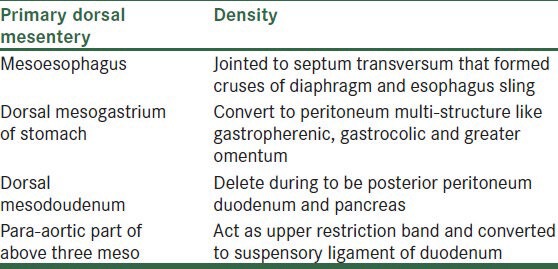
Functional anatomy
The suspensory ligament of the duodenum that has been introduced as the ligament of Trietz, connects the duodeno-jejunal flexure to the right crus of the diaphragm. The functions of this ligament include:
Determining agent of duodenum position and holding of ligament in C form (helps stomach chymous with pancreas and gallbladder enzymes).
Probable support of the small intestine loop and performs this function by sending of collagen fibers to the mesentery scaffold and increases the potential hold of ileum and jejunum.
Microscopic anatomy
It is a suspensory muscle of the duodenum arising from the duodeno-jejunal flexure and a portion of the inferior transverse portion of the duodenum that inserts into the celiac axis, and a slip of the diaphragm arising from the diaphragmatic crus at the esophageal hiatus attaching to the celiac artery axis (Hilfsmuskel: The German word indicates this muscle).[5,6]
Various differences have been expressed in references about the introduction, nature, and composition of the Trietz ligament.
Regarding the opinions on the nature and structure of this ligament (or muscle) expressed elsewhere, we decided to survey the Trietz ligament by examining the microscopic sections in four cadavers and our result may be a window for better recognition of this region.
MATERIALS AND METHODS
We did not have enough cadavers in this study. Thus, our study was performed in fixated cadavers (three male and one female) at the Anatomy department of the Medical School of Isfahan University of Medical Sciences.
The procedure can be briefly described as follows:
Abdominal wall of the cadaver was opened and the duodenum was released by removing the greater omentum using the Kocher method. Then, a similar method was performed in the left region (for separating the spleen and pancreas)
Histological sections were taken from the upper, the middle, and the lower region of the ligament and prepared with routine H and E, Mallory's trichrome stain for detection of collagen fibers and muscle.
-
We selected the lower end of the ligament and intestinal mesentery for detection of collagen fibers from suspensory ligament of duodenum into the mesenteric scaffold. Because the region of our study was extended (from ligament to the intestinal mesenteric side), the rolling method was used that decreased the dimension of the histological sample [Figures 1a and b].
-
The roll was prepared and stained by H and E and Mallory's trichrome methods.We prepared histological sections from three regions of this roll:
- The region where the mesentery is connected to the body wall (root of the mesentery).
- The region where the mesentery is connected to the intestine (intestinal mesenteric side).
- The region present between the two regions mentioned above.
-
The whole sections were pictured (three parts of roll and ligament) and recorded using a development of the light microscope that was equipped with a camera system.
Figure 1a.
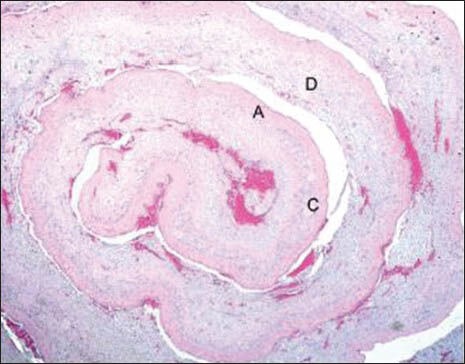
Example of preparing roll for survey of histology of placenta
Figure 1b.
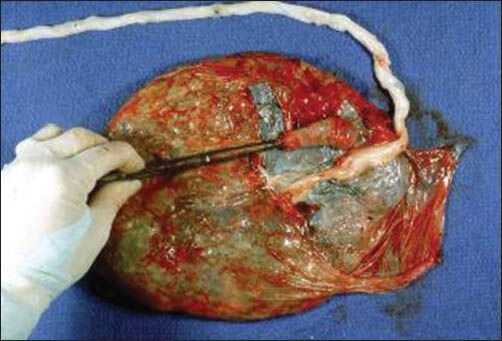
Example of preparing roll for survey of histology of placenta
RESULTS
Our results of the stained sections and microscopic pictures of the upper, middle, and lower parts of Trietz ligament in four cadavers showed that collagen fibers of Trietz ligament had accumulated for the formation of collagen bundles and thus did not show any collagen bundles [Figures 2–4].
Figure 2.
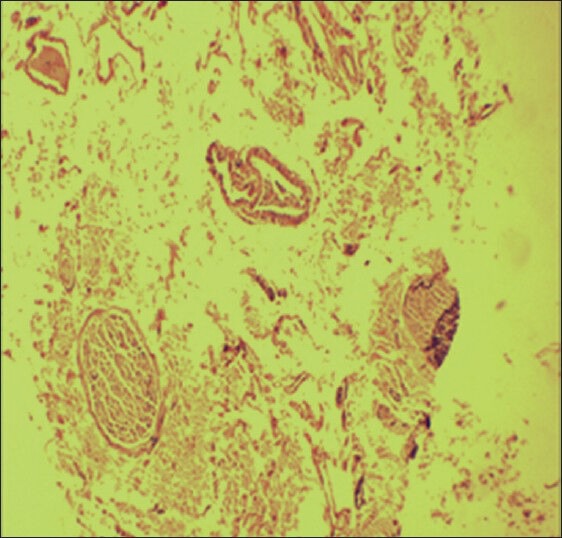
Photomicrograph from upper part of Trietz ligament, H and E staining 40×: Arrow showing smoot or straight muscle bundle in the suspensory muscle of duodenum, fibers of collagen showed that scattered but not detected bundles of collagen
Figure 4.
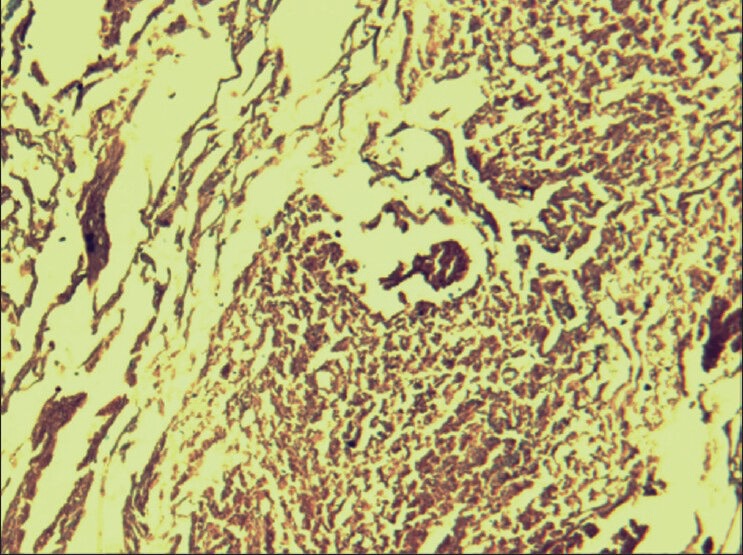
Photomicrograph from lower part of Trietz ligament, Trichrome Mallory staining ×40: Fibers of collagen showed that scattered but not detected bundles of collagen
Figure 3.
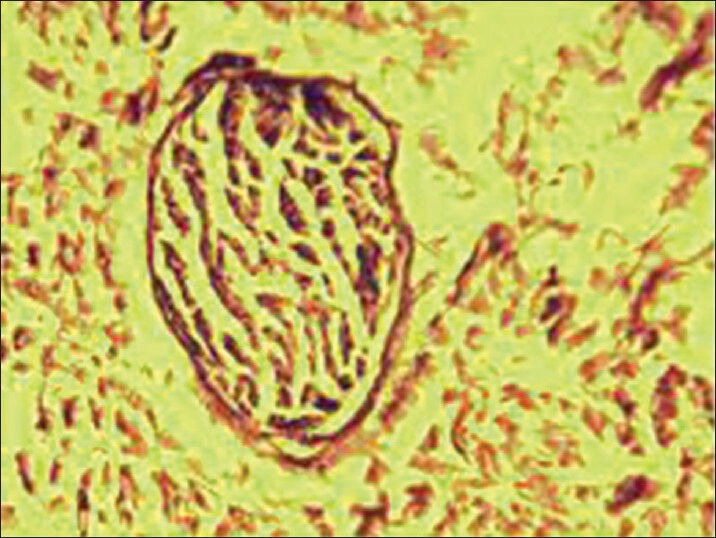
Photomicrograph from middle part of Trietz ligament, trichrome Mallory staining ×40: Fibers of collagen showed that scattered but not detected bundles of collagen
These results showed that in the histological sections of three parts, no muscular bundle existed, only little muscular fibers were detected in the upper and lower parts [Figures 2–4].
In the prepared sections of the roll and mesentery for determination of the stretching collagen fibers of Trietz ligament in mesentery, not collagen bundles were detected [Figures 5–7].
Figure 5.
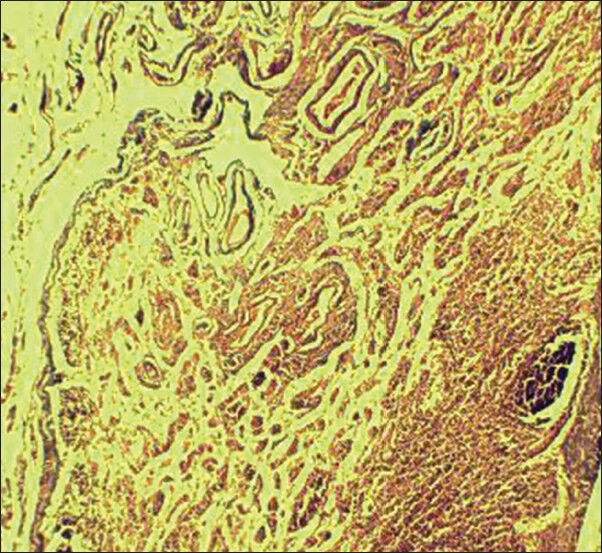
Photomicrograph from roll or mesentery that connected to intestine wall, trichrome Mallory staining ×40: Any bundle collagen detected. Arrow showing artery section
Figure 7.

Photomicrograph from roll or mesentery that connected to body wall, H and E staining ×40: Any bundle collagen detected in this section
Figure 6.
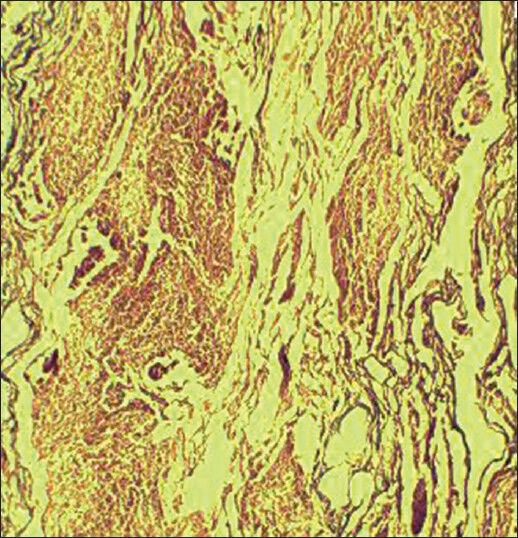
Photomicrograph from middle part of roll or mesentery, trichrome Mallory staining ×40: Fibers of collagen showed that scattered but not detected bundles of collagen
DISCUSSION
Trietz described two structures comprising the ligament that bears his name: A suspensory muscle of the duodenum arising from the duodenal-jejunal flexure and a portion of the inferior transverse portion of the duodenum that inserts into the celiac axis, and a slip of diaphragm arising from the diaphragmatic crus at the esophageal hiatus attached to the celiac artery axis (Hilfsmuskel).[6] Subsequent authors have studied this ligament and reported variable findings [Table 2].
Table 2.
Nature of suspensory muscle of duodenum or Trietz ligament

Jit and Holla had named it “the suspensory muscle complex” and described it as having two parts: The suspensory muscle proper caudally and the accessory muscle (AM) cranially.[8,9]
van der Zypen reported that the fibrous tissue, interconnecting the suspensory muscle of duodenum and the AM, did not develop into a definite tendon even at full term.[10]
Result of this study showed that the suspensory ligament of duodenum had not introduced histological structure ligament in discussion of this article.
Our results showed that the suspensory duodenum did not have collagen and muscular bundle. In this structure, the muscular and collagenous fibers were scattered. Gray described that it commenced from the connective tissue around the celiac artery and left crus of diaphragm only.[11] Results of Gray study were similar our results while Jit and van der Zypen mentioned the presence of muscular fibers of duodenum wall in adult tissue.[8,10]
Hollinshead,[12] Romanes,[13] and McMinn[14] reported a single fibromuscular structure. In the present series, however, two separate structures were detected.
According to the results of this study, the suspensory muscles of the duodenum are composed of irregular connective tissue that contained fascicle dissociated from the muscle. As a result, this ligament did not have collagenous, muscular bundles and we cannot express the proper function of this ligament except as a bridge for cross nerves and arteries.
low, Crymble[15,16] and Trietz also reported that this ligament was mostly composed of muscle.[7]
Any stretching of the Trietz ligament to main mesentery was not observed in the stretching of collagen fibers from suspensory ligament of duodenum into intestine mesentery and there was no existing sign of accumulation of collagen bundle.
Thus, we could not express the supportive role of ligament for mesentery for maintenance of ileum and jejunum.
CONCLUSION
According to the findings of this study and the numerous distinctions mentioned about the structure and the nature of Trietz ligament, further research may be needed on the recent cadavers and new samples, so that we can reach a unanimous agreement on the issue of the Trietz ligament in future and obtain a much better anatomical knowledge of this anatomical element and ligament other than just as a supportive role for mesentery for maintaining the ileum and jejunum.
Footnotes
Source of Support: This project is performed without any financial support
Conflict of Interest: None declared.
REFERENCES
- 1.Frank CB. Ligament structure, physiology and function. J Musculoskelet Neuronal Interact. 2004;4:199–201. [PubMed] [Google Scholar]
- 2.Chowdhury P, Matyas JR, Frank CB. The “epiligament” of the rabbit medial collateral ligament: A quantitative morphological study. Connect Tissue Res. 1991;27:33–50. doi: 10.3109/03008209109006993. [DOI] [PubMed] [Google Scholar]
- 3.Benjamin M, Ralphs JR. The cell and developmental biology of tendons and ligaments. Int Rev Cytol. 2000;196:85–130. doi: 10.1016/s0074-7696(00)96003-0. [DOI] [PubMed] [Google Scholar]
- 4.Lo IK, Chi S, Ivie T, Frank CB, Rattner JB. The cellular matrix: A feature of tensile bearing dense soft connective tissues. Histol Histopathol. 2002;17:523–37. doi: 10.14670/HH-17.523. [DOI] [PubMed] [Google Scholar]
- 5.Argeme M, Mambrin A, Lebreuil G, Guerninel G. Dissection du muscle de Treitz. CR Ass Anat. 1970;147:76–86. [PubMed] [Google Scholar]
- 6.Costacurta L. Anatomical and functional aspects of the human suspensory muscle of the duodenum. Acta Anatom. 1972;82:34–46. doi: 10.1159/000143799. [DOI] [PubMed] [Google Scholar]
- 7.Snell RS. Clinical Anatomy. 2nd ed. Boston: Little, Brown and Company; 1981. The abdomen; pp. 187–91. [Google Scholar]
- 8.Jit I, Grewal SS. The suspensory muscle of the duodenum and its nerve supply. J Anat. 1977;123:397–405. [PMC free article] [PubMed] [Google Scholar]
- 9.Holla SJ. The suspensory muscle of duodenum in human foetuses. J Anat Soc India. 1994;43:111–8. [Google Scholar]
- 10.van der Zypen E, Révész E. Investigation of development, structure and function of the phrenicocolic and duodenal suspensory ligaments. Acta Anat (Basel) 1984;119:142–8. doi: 10.1159/000145876. [DOI] [PubMed] [Google Scholar]
- 11.Gray H. 20th ed. Philadelphia: Lea and Fabiger; 1918. Suspensory muscle of duodenum. Anatomy of the Human Body; p. 1170. [Google Scholar]
- 12.Hollinshead WH. Anatomy for Surgeons. In: Stomach, Duodenum, Pancreas, Spleen, editors. 2nd ed. New York: Harper and Row Publishers Inc; 1971. pp. 407–24. [Google Scholar]
- 13.Romanes GJ. Cunningham's Manual of Practical Anatomy. 15th ed. England: Oxford University Press; 1986. The abdominal cavity; pp. 146–8. [Google Scholar]
- 14.McMinn RM. Last's Anatomy. 9th ed. New York: Churchill Livingstone; 1996. Abdomen; pp. 335–6. [Google Scholar]
- 15.Low A. A note on the crura of the diaphragm and the muscle of Treitz. J Anat Physical. 1908;42:93–96. [PMC free article] [PubMed] [Google Scholar]
- 16.Crymble PT. The muscle of Treitz and the plica duodeno-jejunalis. Br Med J. 1910;2:1156–9. [Google Scholar]


